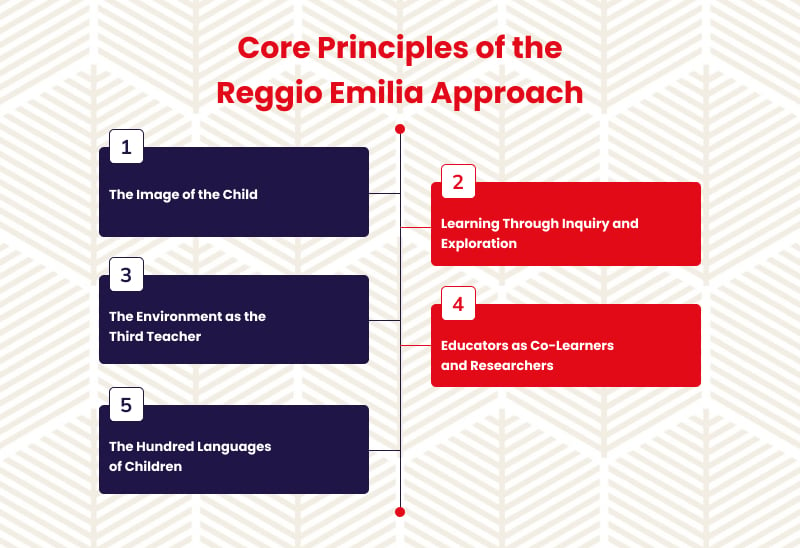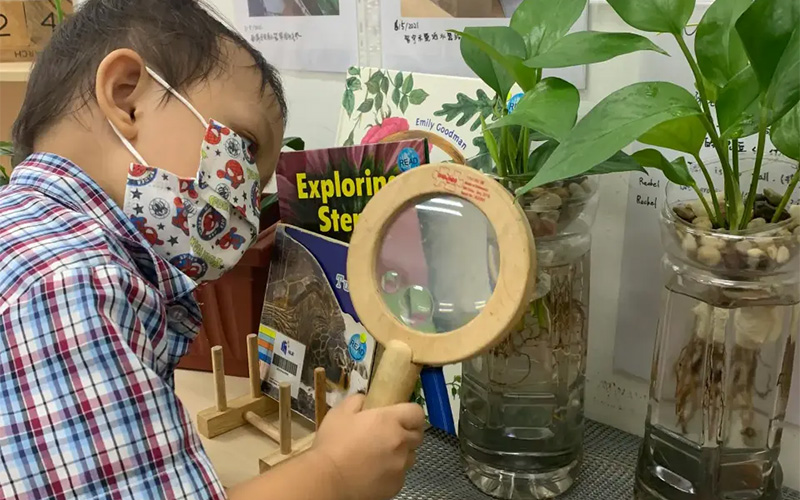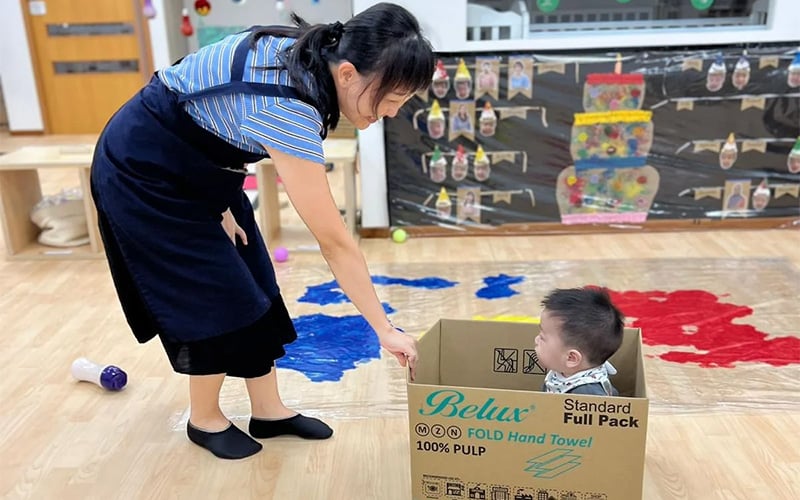In Singapore’s rich early childhood education landscape, parents can choose from a wide range of educational philosophies, from Montessori to more academically focused programmes. Among these, the Reggio Emilia approach stands out for its emphasis on creativity, collaboration, and child-led learning. In an age where results often take centre stage, the question arises: is this approach still relevant today?
Key Takeaways
- The Reggio Emilia approach remains deeply relevant in today’s fast-paced world, offering a respectful, child-led alternative that nurtures curiosity, creativity, and emotional well-being.
- Core principles such as inquiry-based learning, the environment as the third teacher, and the hundred languages of children create a rich, relational foundation for lifelong learning.
- In Singapore, the Reggio Emilia philosophy may feel unfamiliar to parents used to more structured or academic models, but with skilled educators and strong family partnerships, this approach becomes both accessible and impactful.
- Families can expect hands-on, project-based experiences, meaningful documentation instead of grades, and strong emotional connections between educators and children.
- At home, parents can support Reggio Emilia-inspired learning by slowing down, encouraging open-ended play, documenting everyday moments, and being there for their child.
Why the Reggio Emilia Approach Remains Relevant
Rooted in a deep respect for children as capable, curious, and full of potential, the Reggio Emilia approach was born in post-war Italy with a vision to rebuild through education. Decades later, its principles continue to inspire educators and parents around the world, valuing learning as a journey of discovery, collaboration, and creativity.
Core Principles of the Reggio Emilia Approach

1. The Image of the Child
At the heart of the Reggio Emilia approach is the belief that children are not passive recipients of information but active, competent co-constructors of knowledge. They are seen as full of ideas, theories, and perspectives, capable of leading their own learning with curiosity, intention, and creativity. This philosophy empowers children to become confident, resilient learners from their earliest experiences.
2. Learning Through Inquiry and Exploration
Instead of following rigid lesson plans, learning unfolds organically through questions that matter to the child. Educators support children in exploring real-world topics, such as how shadows form or where rain comes from, through project work, dialogue, and experimentation. This emphasis on inquiry and discovery nurtures critical thinking, problem-solving skills, and a lasting sense of wonder about the world around them.
3. The Environment as the Third Teacher
In a Reggio-inspired preschool in Singapore, every element of the environment is intentional. Classrooms are calm, aesthetically pleasing, and filled with natural light and open-ended materials. Spaces are designed to encourage independence, creativity, and connection, with flexible areas for group projects, quiet reflection, and hands-on discovery. These thoughtfully curated environments serve as a “third teacher”, guiding children’s learning alongside educators and peers.
4. Educators as Co-Learners and Researchers
Educators in Reggio Emilia settings observe, listen, and reflect alongside children. They ask open-ended questions, document learning, and design opportunities for deep exploration. This collaborative, responsive role supports children’s unique ways of learning while also modelling curiosity and humility.
5. The Hundred Languages of Children
Children express themselves in countless ways, not only through speech or writing, but also through drawing, sculpting, movement, storytelling, dramatic play, and more. The Reggio Emilia approach honours all these “languages” as meaningful tools for communication and self-expression. This inclusive view allows every child to be seen and heard, whether they are verbal, reserved, or imaginative.
Why the Reggio Emilia Approach Is Beneficial in Today’s Context

The world our children are growing up in has changed dramatically. Days feel busier, screens are ever-present, and expectations seem to arrive earlier than ever. In the face of these changes, the Reggio Emilia approach offers a gentle, thoughtful alternative that honours each child’s pace, curiosity, and emotional world.
1. Helps Children Slow Down and Focus in a Fast-Paced World
Modern life can be overstimulating for young children. Bright screens and noisy toys make it difficult to pause, reflect, or sustain focus. In contrast, Reggio Emilia-inspired kindergarten classrooms in Singapore are designed as calm, welcoming spaces that nurture mindfulness, attention, and depth of thought. Children are encouraged to slow down, notice details, and immerse themselves in their activities, whether they are painting, storytelling, or building.
2. Nurtures Creativity and Collaboration
In an age where automation and technology are advancing rapidly, creativity and collaboration remain vital human strengths. The Reggio Emilia approach nurtures these abilities from the start. Children work on collaborative projects, share their ideas, build on each other’s theories, and express themselves through diverse forms of media. These experiences help them develop confidence, adaptability, and a lifelong love of innovation.
3. Encourages Intrinsic Motivation in a Results-Driven Culture
In Singapore, it’s common for children and even parents to feel the weight of academic pressure from an early age. The focus on grades and achievement can sometimes overshadow a child’s natural curiosity and joy of learning.
Reggio Emilia-inspired classrooms prioritise curiosity over competition. Instead of learning for rewards or test scores, children are invited to ask their own questions, explore topics that interest them, and find meaning in what they learn. This fosters intrinsic motivation, initiative, and a strong sense of self-worth that isn’t tied to external validation.
4. Supports Emotional Regulation and Mental Wellness:
With growing awareness of children’s mental health, the Reggio Emilia approach provides a developmentally sensitive framework for emotional well-being. Children are given time and space to express their feelings, resolve conflicts respectfully, and process experiences at their own pace. Through warm, trusting relationships with educators and peers, they develop emotional literacy and resilience, skills that prepare them to navigate the complexities of today’s world.
Barriers to Adopting the Reggio Emilia Approach Locally

While the Reggio Emilia approach is gaining recognition worldwide, implementing it in local childcare centres comes with certain challenges.
Factors to Consider Beyond Operator Type
1. Might Be Less Familiar to Parents Expecting Traditional Metrics
Parents used to report cards, daily worksheets, and standardised tests may wonder how learning is assessed in a Reggio Emilia classroom. Instead of grades or checklists, progress is made visible through rich documentation, such as photographs, written observations, and curated portfolios. These tools offer a deeper understanding of how your child thinks, creates, collaborates, and grows.
2. Requires Skilled, Reflective Educators
High-quality Reggio Emilia-inspired kindergartens in Singapore depend on educators who can observe sensitively, guide without directing, and respond thoughtfully. Success is not just about setting up attractive spaces; it’s about mindset, ongoing training, and collaboration. At E-Bridge Pre-School, our educators receive continuous professional development and are supported in building strong pedagogical relationships with children and families.
3. The Curriculum Can Feel Too Open-Ended or “Loose”
Some parents value clear structure and daily routines, particularly when preparing children for formal schooling. While the Reggio Emilia approach may appear unstructured at first glance, it actually follows a consistent, child-centred rhythm. Daily rituals such as morning meetings, snack preparation, and group reflections provide security and routine while still allowing learning to unfold naturally.
How to Put the Reggio Emilia Philosophy into Practice
Understanding the philosophy is one thing; seeing it in action is another. For families exploring this approach, it is helpful to know what a day looks like in a Reggio Emilia-inspired preschool or infant care setting in Singapore, and how these values can be carried into your home.
What Families Can Expect at E-Bridge, a Reggio Emilia-Inspired Preschool

At E-Bridge Pre-School, the Reggio Emilia approach is more than a philosophy. It shapes what families see and feel every day. From thoughtfully designed classrooms to the way educators engage with children and parents, every detail supports meaningful, child-led learning. Here’s what you can expect when your child joins our community.
1. A Learning Journey Without Worksheets or Grades
We do not teach children to memorise and recite; we invite them to explore, experiment, and construct meaning. There are no spelling tests or rote writing drills. Instead, children engage in guided, play-based learning, working together on real-world projects, asking open-ended questions, and using materials in inventive ways. Whether investigating how plants grow or designing a pretend shop, learning is active, purposeful, and driven by each child’s interests.
2. Opportunities for Ongoing Parent Involvement
Educators at E-Bridge regularly invite parents to share their insights, contribute materials to class projects, and participate in events that celebrate children’s discoveries. This strengthens the bridge between home and school, helping children feel that their learning is truly valued by the people closest to them.
3. Unexpected Discoveries and Conversations at Home
Children often bring their questions and projects home as inspiration rather than homework. You might find your child building a boat from tissue boxes or asking why the moon changes shape. This is Reggio Emilia-inspired learning at its best: hands-on, meaningful, and full of joy. Home becomes an extension of the classroom, where curiosity continues to grow.
4. A Strong Emotional Connection With Educators
One of the most meaningful aspects of a Reggio Emilia-inspired environment is the quality of relationships. Families often share how well the educators at E-Bridge Pre-School know their child, not just as a student, but as a person with unique ideas, moods, and ways of expressing themselves. When children feel seen, heard, and understood by the adults in their lives, they flourish.
How Parents Can Support Reggio-Inspired Learning at Home

You do not need a beautifully designed classroom or a background in education to support Reggio Emilia values at home. Many of the most meaningful practices are simple, natural, and woven into everyday life.
1. Create Space for Wonder in the Everyday
Children are naturally observant and often notice things adults overlook. A puddle, a ladybird, or the way sunlight dances across the floor can spark curiosity. Invite your child to pause, look closely, ask questions, and explore without rushing. These quiet moments nurture both connection and discovery.
2. Offer Open-Ended Materials
Instead of toys that serve only one purpose, provide items that can be used in many ways—blocks, fabric, cardboard, tape, or even natural materials like stones and leaves. These resources encourage imagination, problem-solving, and storytelling, which are central to the Reggio Emilia approach. There’s no single “correct” way to use them, and that freedom makes them powerful learning tools.
3. Document Special Moments Together
Capture moments of your child’s learning through photos, notes, or drawings. You might take a picture of a block tower, jot down a thoughtful question they asked, or start a shared notebook of their ideas. These small acts of documentation help children feel seen and valued, and give you a deeper glimpse into how they think.
4. Let Questions Lead the Way
When your child asks “why?”, resist the urge to answer immediately. Instead, ask them what they think or suggest finding out together. The Reggio Emilia approach values inquiry over instruction, and some of the richest learning begins not with an answer, but with an open-ended “I wonder…”
5. Slow Down and Be Present
Perhaps the most powerful gift you can offer is your presence. In a world filled with noise and distractions, simply taking the time to sit with your child, listen to their stories, or join them in play creates emotional safety. This quiet, intentional connection can be deeply grounding for your child, and it doesn’t require anything more than your attention and care.
Questions Parents Often Ask
1. Will my child be ready for Primary 1 after attending a Reggio Emilia-inspired preschool?
Yes. Our approach aligns with ECDA’s early childhood curriculum while integrating Reggio Emilia-inspired principles. While we do not rely on worksheets or drilling, children build strong foundations in language, early numeracy, and executive function skills such as focus, flexibility, and problem-solving. At E-Bridge, we also nurture confidence, collaboration, and self-expression, all of which are essential for a smooth transition to formal education in Singapore.
2. Is the Reggio Emilia-inspired approach suitable for quieter or more reserved children?
Absolutely. Our classrooms respect different communication styles. Children do not need to be extroverted or vocal to be fully engaged. Whether a child prefers drawing, building, storytelling, or quiet observation, our educators are trained to recognise and support each child’s unique way of learning, within the framework of ECDA’s curriculum standards.
3. How is the Reggio Emilia-inspired approach different from Montessori?
Both are child-centred philosophies, but they differ in focus and structure. Montessori classrooms follow a set curriculum with specialised materials that children repeat independently. In contrast, our Reggio Emilia-inspired approach is emergent and evolves from children’s questions and collaborative projects. It also emphasises expressive arts, multiple modes of communication, and the environment as a “third teacher,” while remaining aligned with ECDA guidelines to ensure holistic, standards-based learning.
Why the Reggio Emilia-Inspired Approach Still Matters Now More Than Ever
For families who value empathy, connection, and trust in a child’s natural development, the Reggio Emilia-inspired approach remains as relevant today as ever. It sees learning not as a race, but as a meaningful, lifelong journey where children are heard, valued, and actively involved. In thoughtfully designed environments supported by responsive educators, children grow with confidence, curiosity, and joy.
At E-Bridge Pre-School, we believe in the potential for every child. Our programmes follow ECDA guidelines while incorporating Reggio Emilia-inspired principles and guided inquiry, combining creativity, exploration, and readiness for formal education. With warm, thoughtfully designed spaces and affordable kindergarten fees, we make quality early childhood education accessible to all families.
Contact us today to learn more or find a centre near you.
